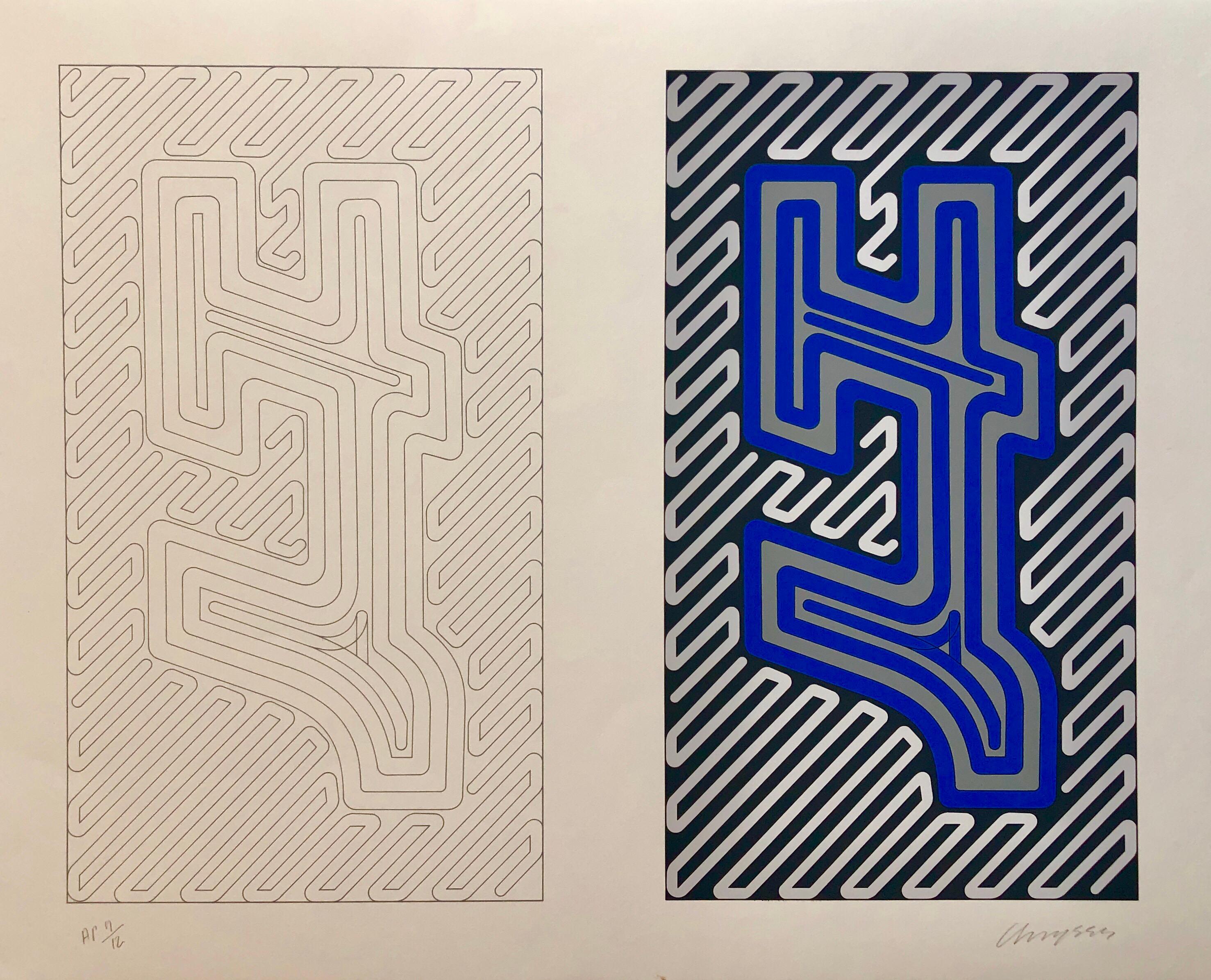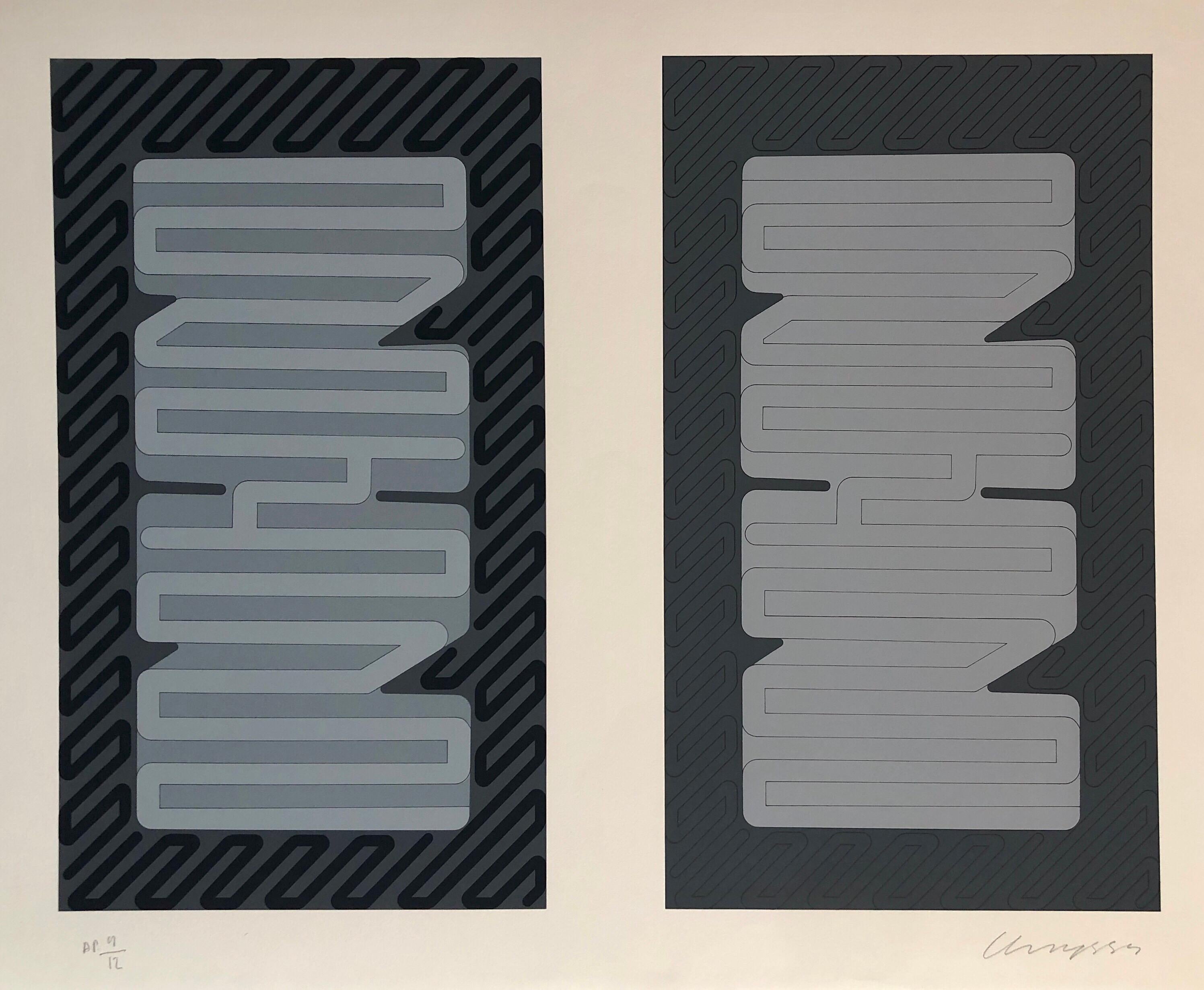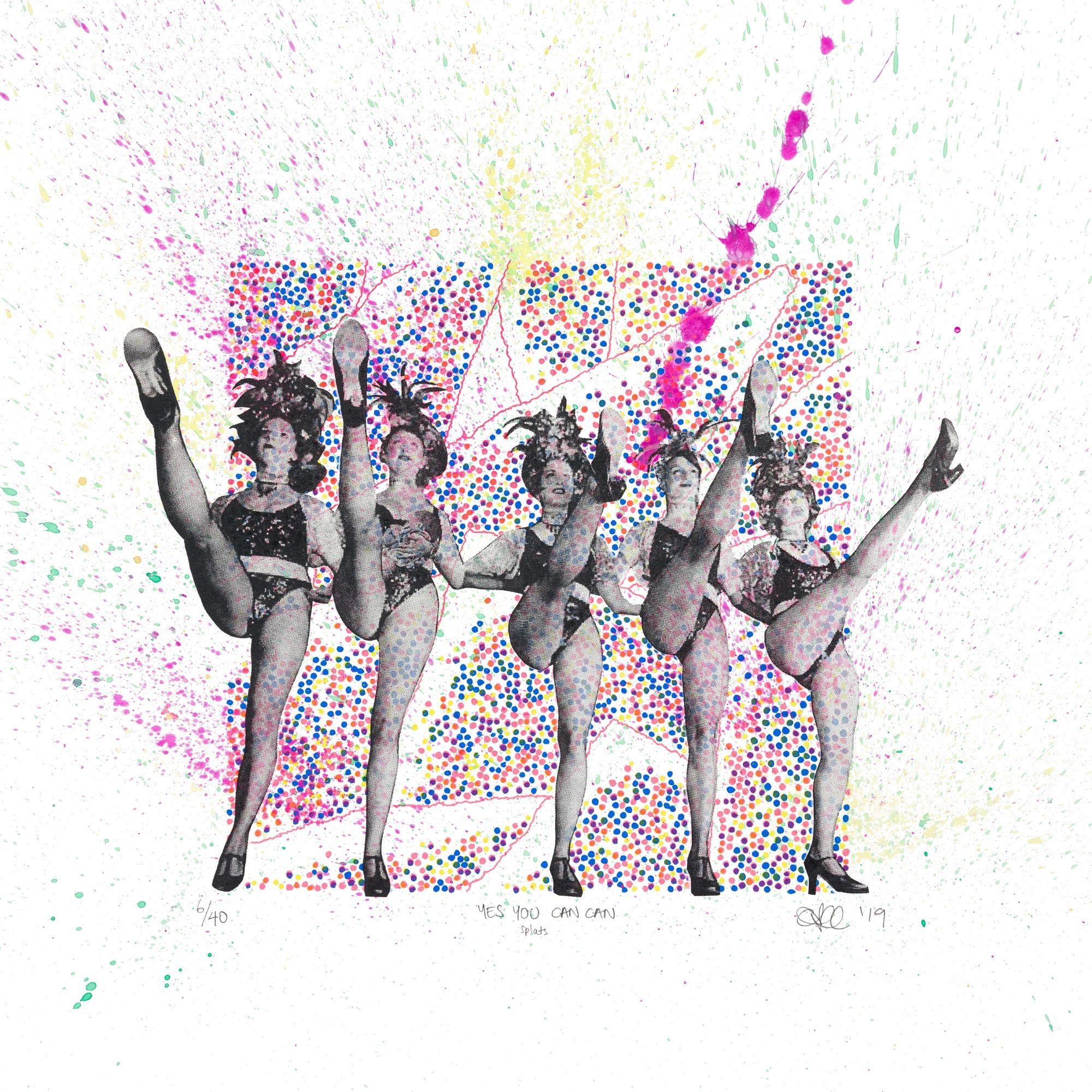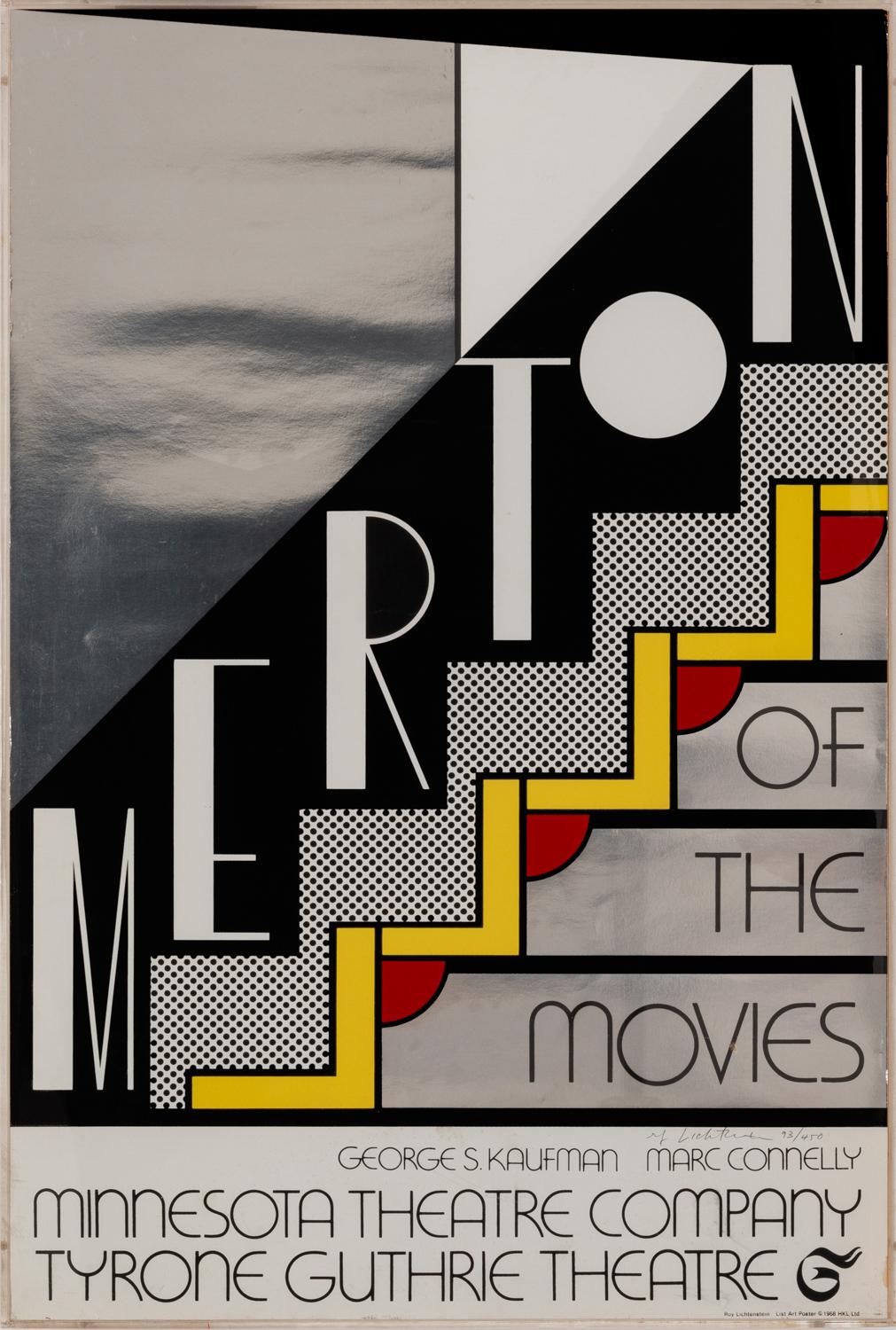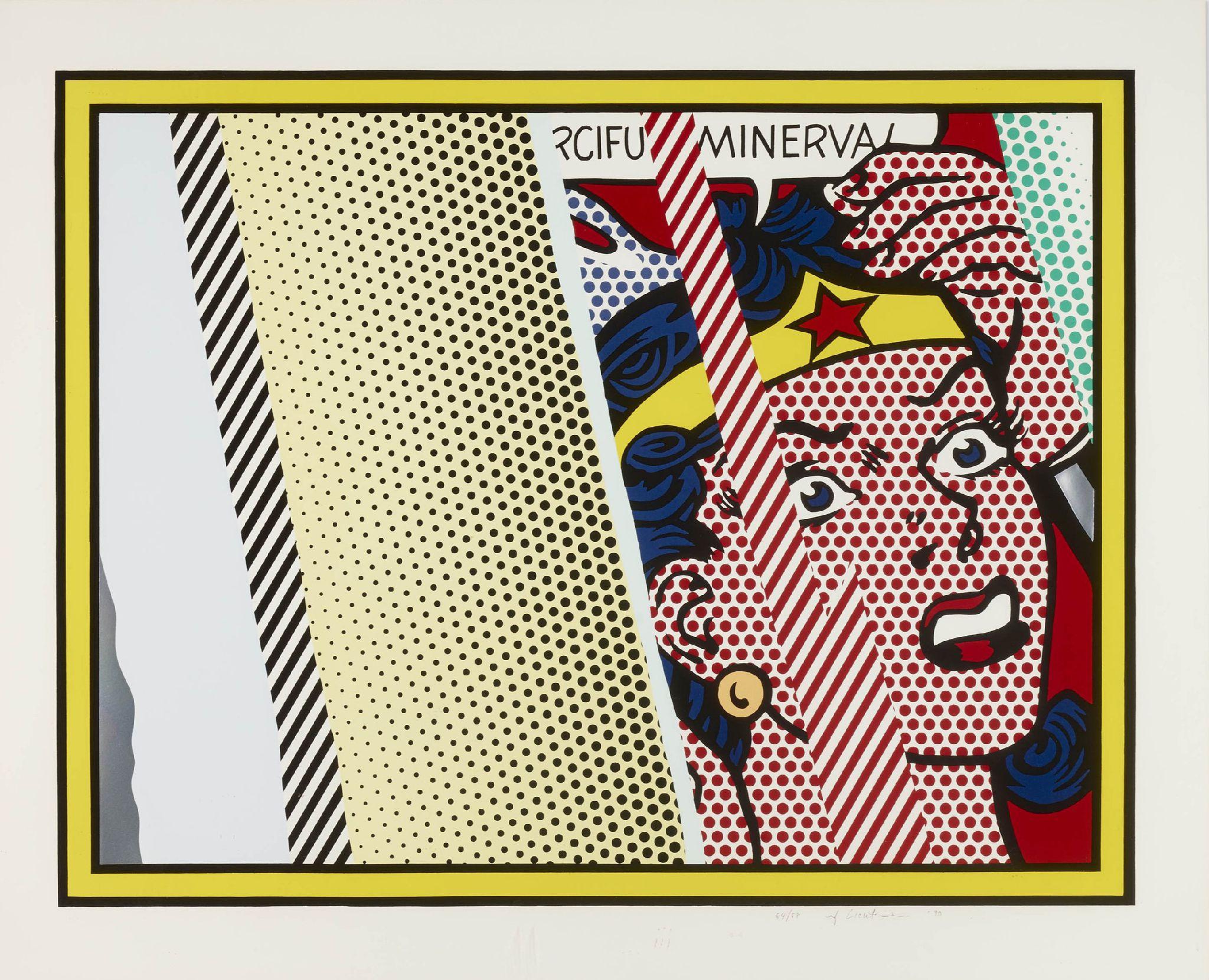Robert IndianaRobert Indiana 4 Americans in Paris MoMa Exhibition Poster1970
1970
About the Item
- Creator:Robert Indiana (1928 - 2018, American)
- Creation Year:1970
- Dimensions:Height: 46.25 in (117.48 cm)Width: 23 in (58.42 cm)Depth: 0.75 in (1.91 cm)
- Medium:
- Movement & Style:
- Period:
- Condition:Not examined outside of the frame.
- Gallery Location:Larchmont, NY
- Reference Number:
Robert Indiana
Robert Indiana's work evolved into hard-edged graphic images of words, logos and typographic forms, earning him a reputation as one of the country's leading contemporary artists.
Indiana is known for using public signs and symbols with altered lettering to make stark and challenging visual statements. In his prints, paintings and constructions, he gave new meaning to basic words like Eat, Die and Love. Using them in bold block letters in vivid colors, he enticed his viewers to look at the commonplace from a new perspective. One indication of his success was the appearance of his immensely popular multi-colored Love on a United States postage stamp in 1973.
Find a collection of original Robert Indiana art today on 1stDibs.
- ShippingRetrieving quote...Ships From: Larchmont, NY
- Return PolicyA return for this item may be initiated within 14 days of delivery.
- Sean Delonas Signed Political CartoonLocated in Larchmont, NYSean Delonas Untitled (sssuuuccckkkeeerrrsss), c. 21st century Screenprint (?) Sight: 9 1/2 x 12 3/4 in. Framed: 18 7/8 x 21 7/8 x 1 in. Signed and inscribed top Signed lower left in plate Best known as the cartoonist for the New York Post’s Page Six from 1990 to 2013. His cartoons are currently syndicated by CagleCartoons and appear worldwide. An award winning painter and illustrator, his work has appeared in the nation's largest newspapers, magazines, books, television and Broadway. Sean's work is in the permanent collections of the Smithsonian - National Museum of American History, the Library of Congress, Brooklyn Museum of Art, Newseum, the Cartoon Art Museum, New York Historical Society Museum and Library, the Billy Ireland Cartoon Library and Museum, appeared in shows at National Museum of Health and Medicine, the Norman Rockwell Museum, the Concord Museum and the Whitney Museum of American Art. Sean's cartoons were responsible for the New York Mets decision to boycott the press in 1992 (New York Daily News, 03/28/1993). In 2009, his cartoons led to worldwide media attention and the largest protest against the New York Post in it's 200+ yr history with many politicians calling for his arrest. Sean's cartoons linking Freddy Ferrer to Al Sharpton "helped decide the 2001 mayoral race" ( New York magazine, March 21-28, 2005) and were mentioned in the NYC Democrat mayoral candidate's concession speech (November 7, 2001). In 2018, New Mexico’s entire congressional delegation condemned Sean for an immigration cartoon based on Trump's State of the Union speech that appeared in the Albuquerque Journal. (New York Times, 02/08/18) A sold out one man art show at the Limner Gallery led to his largest commission -- creating the altar painting for the Church of St. Agnes in NYC. Many of his friends at the NY Post, were the models for this painting. Together with his son, is the author of Scuttle's Big Wish (ReganBooks/HarperCollins 2006 and Scholastic Books 2007) and, Sean Delonas: The Ones They Didn't Print, (Skyhorse Publishing, 2015). Pulitzer prize winner, Mike McAlary’s character, Scar [played by Glenn Fitzgerald], from CBS’s “New York News” was " drawn from that wacky talent, Sean Delonas." Mike McAlary, NEW YORK DAILY NEWS Wednesday, August 2, 1995. His work is in the private collections of celebrities, politicians, and other public figures, including George H.W. Bush, Secretary James Baker, Andrew Lloyd Weber, Rupert Murdoch, Howard Stern, George Steinbrenner, Spike Lee, Rush Limbaugh, Dan Rather, Wolf Blitzer, Steve Kroft, Mario Cuomo, John Cardinal O’Connor, Jackie Mason , Cindy Adams, Pete Hamill, David Blaine...Category
21st Century and Contemporary Contemporary More Prints
MaterialsScreen
- Original Print by Chinese Surrealist Qian GangLocated in Larchmont, NYQian Gang (b. 1958) Untitled, c. late 20th-21st century Lithograph Sight: 7 1/4 x 15 in. Framed: 17 x 21 1/4 in. Signed lower right: Gang Qian Qian Gang was born in Shanghai in 1958. In 1976, the artist was sent to the countryside to be re-educated for the next 5 years of his life. The son of a famous painter...Category
20th Century Modern More Prints
MaterialsLithograph
- Elena Greggio Print After Walter RosenblumLocated in Larchmont, NYElena Greggio (Italian, b. 1973) Untitled (After Walter Rosenblum), 2003 Etching 9 x 12 in. Matte: 14 x 20 in. Signed, dated and inscribed bottom: "Untitled" After Walter Rosenblum, Elena Greggio, 2003 Signed verso and inscribed: Elena Greggio 2003, "Untitled" After Walter Rosenblum, Thanks Walter & Naomi Elena Greggio was born in Padua, Italy. After studying Architecture at Liceo Artistico, she graduated with Hons in Painting at the Accademia di Belle Arti in Venice in 1995. Her final thesis was on G. Klimt and the Wiener Secession, under supervisor Luca Massimo Barbero. Today, she lives and works in Padua, where she dedicates herself to painting and priniting techniques, such as linocut and woodcut. She exhibits and has exhibited in: Italy, United Kingdom, California, Germany, Austria, Bosnia, Herzegovina, Chile, Portugal and Netherlands. Main Exhibitions 2023 - Illustrating the World: Woodcuts in the Age of Dürer. The Holburne Museum, Bath. UK 2023 - Group show: Pagine a colori. Vimercate 2022 - Finalist: International Prize Visioni Altre. Venice 2022 - Group show: Mirror Face to Face. Amstelkerk. Amsterdam, Netherlands 2022 - Group show: Mirror Face to Face. Kunstliefde. Utrecht, Netherlands 2022 - Group show: Mirror Face to Face. Villa Caldogno. Vicenza 2022 - Finalist: We Art...Category
Early 2000s Contemporary More Prints
MaterialsEtching
- Elena Greggio Print After André KertészLocated in Larchmont, NYElena Greggio (Italian, b. 1973) Danza Per André Kertész (After Kertész), 2003 Etching 9 x 12 in. Mat: 14 x 20 in. Edition 1 of 15 Signed, dated and inscribed bottom: Danza Per André Kertész, After André Kertész, Elena Greggio, 2003 Signed and inscribed verso on mat: Elena Greggio 2003, Titolo: Danza Per André Kertész (After Kertész), Con [illegible], Naomi & Walter Rosenblum Elena Greggio was born in Padua, Italy. After studying Architecture at Liceo Artistico, she graduated with Hons in Painting at the Accademia di Belle Arti in Venice in 1995. Her final thesis was on G. Klimt and the Wiener Secession, under supervisor Luca Massimo Barbero. Today, she lives and works in Padua, where she dedicates herself to painting and priniting techniques, such as linocut and woodcut. She exhibits and has exhibited in: Italy, United Kingdom, California, Germany, Austria, Bosnia, Herzegovina, Chile, Portugal and Netherlands. Main Exhibitions 2023 - Illustrating the World: Woodcuts in the Age of Dürer. The Holburne Museum, Bath. UK 2023 - Group show: Pagine a colori. Vimercate 2022 - Finalist: International Prize Visioni Altre. Venice 2022 - Group show: Mirror Face to Face. Amstelkerk. Amsterdam, Netherlands 2022 - Group show: Mirror Face to Face. Kunstliefde. Utrecht, Netherlands 2022 - Group show: Mirror Face to Face. Villa Caldogno. Vicenza 2022 - Finalist: We Art...Category
Early 2000s Contemporary More Prints
MaterialsEtching
- Tim Engelland Woodcut of a RestaurantLocated in Larchmont, NYTim Engelland (American, 1950-2012) Untitled, From a Holiday Portfolio Printed for Deerfield Academy, 1992 Woodcut on Rives Lightweight Buff paper 9 1/2 x 12 1/2 in. Signed lower right and numbered 120/125 This print is from a portfolio group printed by Michael Holden at Reed Art...Category
1990s Contemporary More Prints
MaterialsWoodcut
- Classic Bar Scene by Tim Engelland, Deerfield AcademyLocated in Larchmont, NYTim Engelland (American, 1950-2012) Last Call, 1993 Woodcut 9 x 12 in. Signed dated lower right: 1993 T. Engelland Titled and numbered bottom: Last Call, 40/125 A lifelong artist, Engelland specialized in oil portraits and landscapes, and also worked extensively in woodcuts and linocuts. He was born on Jan. 5, 1950, in Ames, Iowa, the son of Charles Wilbur “Will” Engelland and Patricia Fairman Engelland.. Tim grew up in Terre Haute, IN, attending Fairbanks Elementary School and Indiana State University’s Laboratory School. He knew he wanted to be an artist from an early age, and was mentored by Lab School’s John Laska, graduating in 1968. He received a BFA from Temple University’s Tyler School of Art; was a Norfolk Fellow at Yale University; and received his MFA from Cornell University, teaching there for two years after graduation. He spent the majority of his career, from 1976-2004, at Deerfield...Category
1990s Modern More Prints
MaterialsWoodcut
- 1970's Large Silkscreen Abstract Geometric Day Glo Serigraph Pop Art Print NeonBy Chryssa Vardea-MavromichaliLocated in Surfside, FLSilkscreen on Arches paper, Hand signed and Numbered in Pencil. Serigraph in blue gray (silver). Chryssa Vardea-Mavromichali (Greek: Χρύσα Βαρδέα-Μαυρομιχάλη; December 31, 1933 – December 23, 2013) was a Greek American artist who worked in a wide variety of media. An American art pioneer in light art and luminist sculpture widely known for her neon, steel, aluminum and acrylic glass installations, she has always used the mononym Chryssa professionally. She worked from the mid-1950s in New York City studios and worked since 1992 in the studio she established in Neos Kosmos, Athens, Greece. Chryssa was born in Athens into the famous Mavromichalis family from the Mani Peninsula. one of her sisters, who studied medicine, was a friend of the poet and novelist Nikos Kazantzakis. Chryssa began painting during her teenage years and also studied to be a social worker.In 1953, on the advice of a Greek art critic, her family sent her to Paris to study at the Académie de la Grande Chaumiere where Andre Breton, Edgard Varese, and Max Ernst were among her associates and Alberto Giacometti was a visiting professor. In 1954, at age twenty-one, Chryssa sailed for the United States, arrived in New York and went to San Francisco, California to study at the California School of Fine Arts. Returning to New York in 1955, she became a United States citizen and established a studio in the city. Chryssa's first major work was The Cycladic Books preceded American minimalism by seventeen years. 1961, Chryssa's first solo exhibition was mounted at The Guggenheim. 1963, Chryssa's work was shown at the Museum of Modern Art in curator Dorothy Canning Miller's Americans 1963 exhibition. The artists represented in the show also included Richard Anuszkiewicz, Lee Bontecou, Robert Indiana, Richard Lindner, Marisol, Claes Oldenburg, Ad Reinhardt, James Rosenquist and others. 1966, The Gates to Times Square, regarded as "one of the most important American sculptures of all time" and "a thrilling homage to the living American culture of advertising and mass communications." The work is a 10 ft cube installation of two huge letter 'A's through which visitors may walk into "a gleaming block of stainless steel and Plexiglas that seems to quiver in the play of pale blue neon light" which is controlled by programmed timers. First shown in Manhattan's Pace Gallery, it was given to the Albright-Knox Art Gallery in Buffalo, New York in 1972. 1972, The Whitney Museum of American Art mounted a solo exhibition of works by Chryssa. That's All (early 1970s), the central panel of a triptych related to The Gates of Times Square, was acquired by the Museum of Modern Art between 1975 and 1979. 1973, Chryssa's solo exhibition at the Gallerie Denise René was reviewed for TIME magazine by art critic Robert Hughes before it went on to the Galleries Denise René in Düsseldorf and Paris. Other works by Chryssa in composite honeycomb aluminum and neon in the 1980s and 1990s include Chinatown, Siren, Urban Traffic, and Flapping Birds. Chryssa 60/90 retrospective exhibition in Athens in the Mihalarias Art Center. After her long absence from Greece, a major exhibition including large aluminum sculptures - cityscapes, "neon boxes" from the Gates to the Times Square, paintings, drawings etc. was held in Athens. In 1992, after closing her SoHo studio, which art dealer Leo Castelli had described as "one of the loveliest in the world," Chryssa returned to Greece. She found a derelict cinema which had become a storeroom stacked with abandoned school desks and chairs, behind the old Fix Brewery near the city center in Neos Kosmos, Athens. Using the desks to construct enormous benches, she converted the space into a studio for working on designs and aluminum composite honeycomb sculptures...Category
1980s Pop Art Abstract Prints
MaterialsScreen
- 1970's Large Silkscreen Abstract Geometric Day Glo Serigraph Pop Art Print NeonBy Chryssa Vardea-MavromichaliLocated in Surfside, FLSilkscreen on Arches paper, Hand signed and Numbered in Pencil. Serigraph in white, back, blue gray (silver). Chryssa Vardea-Mavromichali (Greek: Χρύσα Βαρδέα-Μαυρομιχάλη; December 31, 1933 – December 23, 2013) was a Greek American artist who worked in a wide variety of media. An American art pioneer in light art and luminist sculpture widely known for her neon, steel, aluminum and acrylic glass installations, she has always used the mononym Chryssa professionally. She worked from the mid-1950s in New York City studios and worked since 1992 in the studio she established in Neos Kosmos, Athens, Greece. Chryssa was born in Athens into the famous Mavromichalis family from the Mani Peninsula. one of her sisters, who studied medicine, was a friend of the poet and novelist Nikos Kazantzakis. Chryssa began painting during her teenage years and also studied to be a social worker.In 1953, on the advice of a Greek art critic, her family sent her to Paris to study at the Académie de la Grande Chaumiere where Andre Breton, Edgard Varese, and Max Ernst were among her associates and Alberto Giacometti was a visiting professor. In 1954, at age twenty-one, Chryssa sailed for the United States, arrived in New York and went to San Francisco, California to study at the California School of Fine Arts. Returning to New York in 1955, she became a United States citizen and established a studio in the city. Chryssa's first major work was The Cycladic Books preceded American minimalism by seventeen years. 1961, Chryssa's first solo exhibition was mounted at The Guggenheim. 1963, Chryssa's work was shown at the Museum of Modern Art in curator Dorothy Canning Miller's Americans 1963 exhibition. The artists represented in the show also included Richard Anuszkiewicz, Lee Bontecou, Robert Indiana, Richard Lindner, Marisol, Claes Oldenburg, Ad Reinhardt, James Rosenquist and others. 1966, The Gates to Times Square, regarded as "one of the most important American sculptures of all time" and "a thrilling homage to the living American culture of advertising and mass communications." The work is a 10 ft cube installation of two huge letter 'A's through which visitors may walk into "a gleaming block of stainless steel and Plexiglas that seems to quiver in the play of pale blue neon light" which is controlled by programmed timers. First shown in Manhattan's Pace Gallery, it was given to the Albright-Knox Art Gallery in Buffalo, New York in 1972. 1972, The Whitney Museum of American Art mounted a solo exhibition of works by Chryssa. That's All (early 1970s), the central panel of a triptych related to The Gates of Times Square, was acquired by the Museum of Modern Art between 1975 and 1979. 1973, Chryssa's solo exhibition at the Gallerie Denise René was reviewed for TIME magazine by art critic Robert Hughes before it went on to the Galleries Denise René in Düsseldorf and Paris. Other works by Chryssa in composite honeycomb aluminum and neon in the 1980s and 1990s include Chinatown, Siren, Urban Traffic, and Flapping Birds. Chryssa 60/90 retrospective exhibition in Athens in the Mihalarias Art Center. After her long absence from Greece, a major exhibition including large aluminum sculptures - cityscapes, "neon boxes" from the Gates to the Times Square, paintings, drawings etc. was held in Athens. In 1992, after closing her SoHo studio, which art dealer Leo Castelli had described as "one of the loveliest in the world," Chryssa returned to Greece. She found a derelict cinema which had become a storeroom stacked with abandoned school desks and chairs, behind the old Fix Brewery near the city center in Neos Kosmos, Athens. Using the desks to construct enormous benches, she converted the space into a studio for working on designs and aluminum composite honeycomb sculptures...Category
1980s Pop Art Abstract Prints
MaterialsScreen
- 1970's Large Silkscreen Abstract Geometric Day Glo Serigraph Pop Art Print NeonBy Chryssa Vardea-MavromichaliLocated in Surfside, FLSilkscreen on Arches paper, Hand signed and Numbered in Pencil. Serigraph in black, gray (silver). Chryssa Vardea-Mavromichali (Greek: Χρύσα Βαρδέα-Μαυρομιχάλη; December 31, 1933 – December 23, 2013) was a Greek American artist who worked in a wide variety of media. An American art pioneer in light art and luminist sculpture widely known for her neon, steel, aluminum and acrylic glass installations, she has always used the mononym Chryssa professionally. She worked from the mid-1950s in New York City studios and worked since 1992 in the studio she established in Neos Kosmos, Athens, Greece. Chryssa was born in Athens into the famous Mavromichalis family from the Mani Peninsula. one of her sisters, who studied medicine, was a friend of the poet and novelist Nikos Kazantzakis. Chryssa began painting during her teenage years and also studied to be a social worker.In 1953, on the advice of a Greek art critic, her family sent her to Paris to study at the Académie de la Grande Chaumiere where Andre Breton, Edgard Varese, and Max Ernst were among her associates and Alberto Giacometti was a visiting professor. In 1954, at age twenty-one, Chryssa sailed for the United States, arrived in New York and went to San Francisco, California to study at the California School of Fine Arts. Returning to New York in 1955, she became a United States citizen and established a studio in the city. Chryssa's first major work was The Cycladic Books preceded American minimalism by seventeen years. 1961, Chryssa's first solo exhibition was mounted at The Guggenheim. 1963, Chryssa's work was shown at the Museum of Modern Art in curator Dorothy Canning Miller's Americans 1963 exhibition. The artists represented in the show also included Richard Anuszkiewicz, Lee Bontecou, Robert Indiana, Richard Lindner, Marisol, Claes Oldenburg, Ad Reinhardt, James Rosenquist and others. 1966, The Gates to Times Square, regarded as "one of the most important American sculptures of all time" and "a thrilling homage to the living American culture of advertising and mass communications." The work is a 10 ft cube installation of two huge letter 'A's through which visitors may walk into "a gleaming block of stainless steel and Plexiglas that seems to quiver in the play of pale blue neon light" which is controlled by programmed timers. First shown in Manhattan's Pace Gallery, it was given to the Albright-Knox Art Gallery in Buffalo, New York in 1972. 1972, The Whitney Museum of American Art mounted a solo exhibition of works by Chryssa. That's All (early 1970s), the central panel of a triptych related to The Gates of Times Square, was acquired by the Museum of Modern Art between 1975 and 1979. 1973, Chryssa's solo exhibition at the Gallerie Denise René was reviewed for TIME magazine by art critic Robert Hughes before it went on to the Galleries Denise René in Düsseldorf and Paris. Other works by Chryssa in composite honeycomb aluminum and neon in the 1980s and 1990s include Chinatown, Siren, Urban Traffic, and Flapping Birds. Chryssa 60/90 retrospective exhibition in Athens in the Mihalarias Art Center. After her long absence from Greece, a major exhibition including large aluminum sculptures - cityscapes, "neon boxes" from the Gates to the Times Square, paintings, drawings etc. was held in Athens. In 1992, after closing her SoHo studio, which art dealer Leo Castelli had described as "one of the loveliest in the world," Chryssa returned to Greece. She found a derelict cinema which had become a storeroom stacked with abandoned school desks and chairs, behind the old Fix Brewery near the city center in Neos Kosmos, Athens. Using the desks to construct enormous benches, she converted the space into a studio for working on designs and aluminum composite honeycomb sculptures...Category
1980s Pop Art Abstract Prints
MaterialsScreen
- Yes You Can CanLocated in Deddington, GBYes You Can Can (Splats Edition) by Amy Gardner [2020] limited_edition Screen Print, Watercolour Edition number 40 Image size: H:50 cm x W:50 cm Sold Unframed Please note that insitu images are purely an indication of how a piece may look Only AP works left in this edition. This print is about women supporting women. 'YES YOU CAN CAN' splats edition limited edition of 40 Archival Bread & Butter bright white paper 270gsm 50x 50cms 5 screen...Category
21st Century and Contemporary Pop Art Figurative Prints
MaterialsPaper, Watercolor, Screen
- Merton of the movies, 1968, Serigrafia, Pop Art americana, CinemaBy Roy LichtensteinLocated in Milano, ITMerton of the movies, 1968 by Roy Lichtenstein. The work is a Silkscreen on silver paper, 76 × 51 × 0.2 cm, Edition 93/450. Literature: Co-published by Lincoln Center/List Poster...Category
1960s Pop Art More Prints
MaterialsPaper, Screen
- Reflections on MinervaBy Roy LichtensteinLocated in Philadelphia, PARoy Lichtenstein Reflections on Minerva 1990 Lithograph, screenprint, relief, and metalized PVC collage with embossing on mold-made Somerset paper Signed, numbered, and dated in pen...Category
1990s Pop Art More Prints
MaterialsLithograph, Screen

